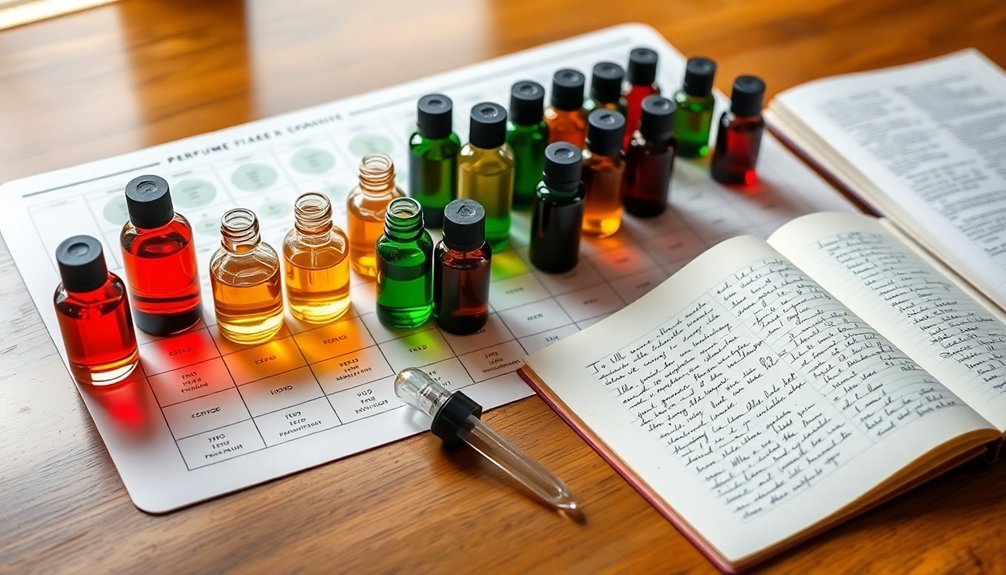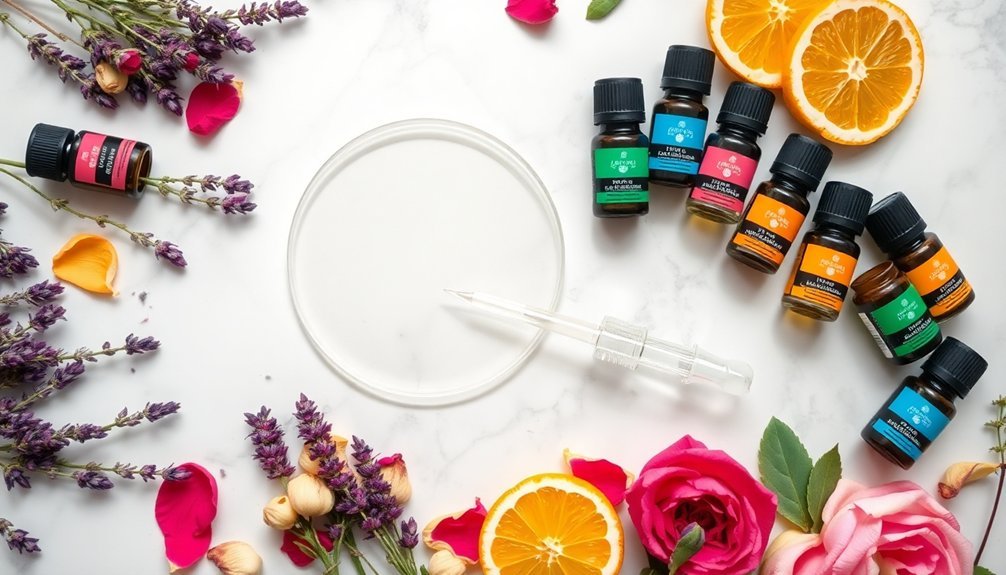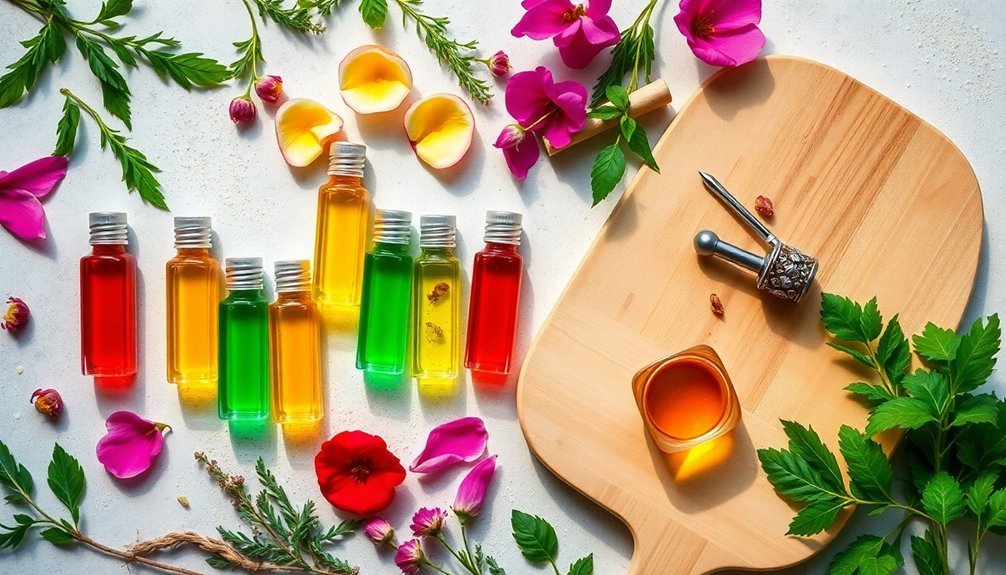Creating your signature scent starts with understanding the four main fragrance families: floral, oriental, woody, and fresh. You'll want to follow a classic ratio of 30% top notes (first impression), 50% middle notes (the heart), and 20% base notes (lasting foundation). Begin by testing combinations on blending strips, documenting your preferences, and adjusting for seasonal changes. Following proven mixing charts and safety guidelines will help you reveal the perfect custom fragrance combination.
Understanding the Art of Fragrance Families

When venturing into the world of perfume mixing, understanding fragrance families serves as your foundation for creating successful scent combinations. The four main families – floral, oriental, woody, and fresh – each bring distinct characteristics to your blend.
You'll find floral scents offer sweet, feminine notes like rose and jasmine, while oriental fragrances deliver exotic spices and resins. Woody scents contribute warm, opulent tones through ingredients like patchouli and sandalwood. Fresh fragrances round out the spectrum with clean, bright notes from citrus and herbs. Michael Edwards developed this revolutionary fragrance classification system to make scent selection more efficient for retailers and consumers.
Each family breaks down into specialized subfamilies. For example, floral branches into categories like fruity, soft floral, and floral oriental, while fresh includes aromatic, citrus, green, and water.
Understanding these subcategories helps you create more nuanced and sophisticated fragrance combinations.
Essential Building Blocks: Top, Middle, and Base Notes
You'll find that creating a balanced perfume requires careful attention to the ratios between different fragrance notes, with middle notes typically making up 50-75% of the blend, top notes 20-40%, and base notes 5-10%.
When mixing your perfume, consider how top notes provide the initial burst of scent, middle notes create the heart of your fragrance, and base notes anchor the entire composition with lasting power. Top notes are particularly distinctive, as they evaporate within minutes to make way for the emerging heart notes.
Understanding these characteristics helps you craft harmonious blends, as each note plays its unique role: top notes captivate with fresh, volatile scents; middle notes balance with floral and spicy elements; and base notes ground the fragrance with rich, enduring aromas.
Scent Ratios and Balance
Creating a perfectly balanced perfume requires understanding the precise ratios between top, middle, and base notes.
You'll want to start with middle notes, which form 40-60% of your blend and serve as the heart of your fragrance. These floral or herbal elements bridge your composition together. Rich scents like jasmine and ylang-ylang create an exotic warmth in middle notes.
Next, incorporate top notes at 15-20% of your formula. These quick-evaporating scents, like citrus, create your perfume's first impression.
Finally, add base notes at 20-30% to provide lasting power and foundation through deep, grounding elements like sandalwood or vanilla.
To achieve the right balance, you'll need to experiment carefully, adding ingredients drop by drop.
Test your creation on skin and allow it to mature, paying attention to how the scent develops over time.
This methodical approach guarantees your signature scent has proper structure and harmony.
Fragrance Note Characteristics
Understanding fragrance note characteristics begins with three essential building blocks that create a perfume's complete aromatic journey.
Top notes give you that first burst of scent, typically lasting 15-30 minutes with fresh, citrusy elements like bergamot and lemon. They're your fragrance's first impression.
Middle notes, or heart notes, emerge as top notes fade, forming about 70% of your scent's personality. You'll find floral oils like jasmine and ylang-ylang, along with spices like cinnamon, lasting several hours.
Base notes are your fragrance's foundation, providing depth and staying power. They'll linger the longest on your skin, sometimes for days.
These notes include rich elements like sandalwood, musk, and vanilla, giving your perfume its lasting signature and warmth.
Your Personal Scent Profile Assessment

How well do you know your personal scent preferences? To discover your unique fragrance profile, you'll need to conduct a systematic assessment using proper testing techniques.
Start by finding a neutral environment free from competing odors. Apply a small amount of perfume to clean skin, preferably on the back of your hand. Take gentle, deep breaths to analyze the scent's progression over time, noting your immediate emotional responses and memories triggered.
Track how the fragrance develops through its top, heart, and base notes. Document your observations about the perfume's longevity, sillage, and overall balance. Pay attention to which notes resonate most with you and which ones feel overwhelming.
Use coffee beans between testing different scents to reset your nose and prevent olfactory fatigue.
The Science Behind Successful Perfume Blending
To blend perfumes successfully, you'll need to master both the artistry and chemistry behind fragrance composition. Understanding how different aromatic compounds interact with your olfactory receptors is essential for creating harmonious combinations.
When you're blending, start by selecting 2-3 key ingredients that'll form your fragrance's heart. Remember that molecular size affects how quickly scents evaporate – lighter top notes like citrus dissipate within 30 minutes, while heavier base notes like woods provide lasting power.
You'll want to add modifiers drop by drop, using blender oils to bridge different notes together. Pay attention to how synthetic and natural ingredients work together, and don't forget to include fixatives for stability.
Your final creation should mature in a cool, dark place, allowing the components to merge into a sophisticated, well-balanced scent.
Creating Your Custom Mixing Chart

A well-organized mixing chart serves as your roadmap for creating stunning fragrances that consistently deliver desired results.
Start by listing your chosen top, middle, and base notes in separate columns, including both essential oils and fragrance oils you'll use. For each ingredient, note the recommended fragrance load percentage and carrier agent requirements.
Create sections for your favorite accords and record successful blending ratios. You'll want to include space for testing notes, where you can document skin and paper test results.
Add columns for adjustments made during the creation process, helping you track what works and what doesn't. Remember to note precise measurements using your scale and pipettes – even small variations can greatly impact the final scent.
This systematic approach guarantees you can replicate your successful formulas while refining your signature blends.
Proportions and Ratios for Perfect Balance
Your perfume's success depends on balancing the proper ratios of top, middle, and base notes, with the standard 30:50:20 ratio serving as an excellent starting point.
You'll achieve the most balanced results by following a systematic distribution chart, where a 60-drop blend would use 18 drops of top notes, 30 drops of middle notes, and 12 drops of base notes.
For precise measurements, you should use a scale rather than counting drops, as oil densities vary considerably and can affect your final composition.
Essential Oil Ratio Chart
Creating balanced essential oil blends requires understanding fundamental ratios and proportions. The 30-50-20 rule serves as your foundation: use 30% top notes for initial impact, 50% middle notes for the core scent, and 20% base notes for lasting depth. For a 100-drop blend, that's 30, 50, and 20 drops respectively.
Consider each oil's role in your blend. Personifier oils like lavender or bergamot should make up 50-80% of your mixture, while enhancers, equalizers, and modifiers complete the composition.
Remember that aroma strength differs from evaporation rate – you'll need to adjust ratios accordingly. For topical applications, mix 15 drops of essential oils per 30ml of carrier oil.
Start small with a 4/6/2 ratio (top/middle/base) and test on perfume strips before scaling up your blend.
Blending Base-to-Top Distribution
Three essential layers form the foundation of every successful perfume blend: base notes for lasting depth, middle notes for core character, and top notes for initial impact.
To achieve the perfect balance, you'll want to follow proven ratio guidelines. The classic 30-50-20 distribution offers a reliable starting point: use 30% top notes for freshness, 50% middle notes for body, and 20% base notes for longevity.
For seasonal adjustments, increase your base notes up to 30% in autumn and winter blends, while keeping lighter proportions for spring and summer scents.
You can also experiment with alternative ratios: try 1:1:1 for equal distribution, 3:2:1 for enhanced top notes, or 4:2:1 when you want the initial impression to really stand out.
Test each combination to find your ideal balance.
Common Fragrance Combinations That Work

When exploring the art of perfume mixing, certain fragrance combinations consistently deliver enchanting results.
You'll find that floral-citrus blends create revitalizing scents, while woody-rose combinations offer sophisticated complexity.
Fresh-peppery pairings provide an invigorating contrast, and oriental-fruity mixes deliver exotic allure.
- Try blending Rose Geranium with Apple and Mad About Mint for a crisp apple rose water scent that's perfect for spring.
- Create a masculine rose fragrance by combining Rose Geranium with Oudh Wood for a deep, sophisticated rosewood aroma.
- Mix Satsuma Orange with Ginger & Lime and Champagne for an energizing summer citrus spritzer.
- Blend Blackberry Bliss with Champagne for an elegant blackberry bubbly that's perfect for evening wear.
Seasonal Adjustments for Your Signature Blend
As seasons change, your signature fragrance blend should evolve to complement the shifting weather and atmosphere.
In summer, lighten your blend with citrus and fresh floral notes, opting for Eau de Toilette concentrations that won't overwhelm in the heat and humidity.
When spring arrives, incorporate airy florals like rose and iris, paired with green notes for a seasonal shift.
As autumn approaches, adjust your blend by adding warm spices, vanilla, or amber to create depth.
Remember that temperature greatly affects how your fragrance projects – heat intensifies top notes while cold weather emphasizes base notes.
You'll need to adapt your mixture's concentration accordingly.
Consider humidity levels too, as they can amplify certain notes, especially sweet and floral ones.
Layer complementary scents to maintain consistency throughout seasonal changes.
Documenting and Refining Your Creation

Recording your perfume blending journey helps you replicate successful formulas and learn from each creation, making systematic documentation of ingredients, ratios, and observations essential.
You'll need to keep detailed records of your recipes, including exact measurements and mixing sequences, while using blending strips to test and evaluate your fragrances before making adjustments.
Through methodical testing and patient refinement, you can fine-tune your blend until it achieves the perfect balance of top, middle, and base notes.
Track Your Scent Journey
Creating your own perfume is an artistic journey that demands meticulous documentation and ongoing refinement.
You'll need to track every step of your process, from your initial formula to each adjustment you make along the way.
- Keep detailed records of ingredient ratios and proportions
- Test your fragrance on different mediums (skin, fabric, scent strips)
- Document how the scent evolves over time
- Note any modifications and their results
Allow your creation to mature and evaluate it periodically to guarantee the notes blend harmoniously.
Pay attention to how the top, heart, and base notes perform both individually and together.
When you identify gaps or imbalances, make incremental adjustments to achieve your desired scent profile.
Remember to use high-quality ingredients consistently to maintain the integrity of your signature fragrance.
Recipe Recording Best Practices
The art of documenting your perfume creations demands a systematic approach to capture every detail of your formulation process.
Start by using a dedicated recipe card or notebook where you'll record the fragrance name, creation date, and your inspiration.
Track up to 16 ingredients, listing their measurements by drops or weight, and categorize them into top, heart, and base notes.
You'll want to document both initial impressions and how the scent evolves after aging. Use fragrance strips to test combinations before final blending, and don't forget to wave them under your nose to evaluate the blend.
Keep your workspace organized with clean, dark glass bottles, and filter your perfumes through coffee filters to remove sediment.
Let your creation age for at least 48 hours, noting any changes in the scent profile before making adjustments.
Fine-Tuning Through Testing
While developing your signature scent, systematic testing becomes your most valuable tool for achieving the perfect blend.
You'll need to employ various testing methods, from blotter paper to skin tests, to understand how your fragrance evolves over time. Use facial tissues for a more accurate representation of the scent's interaction with air molecules.
Document your testing process meticulously by:
- Recording detailed notes about each stage of the scent development
- Tracking the evolution of fragrances over 1-3 hours
- Comparing multiple samples to identify the best combination
- Evaluating how the blend interacts with your body chemistry
Focus on understanding how your top notes shift into heart notes, and adjust the ratios accordingly.
Remember to limit testing to three fragrances at a time to prevent olfactory fatigue.
Safety Guidelines and Best Practices

Safe handling of fragrance oils requires four essential pieces of protective equipment: a respirator with organic vapor filters, chemical-resistant gloves, protective goggles, and well-ventilated workspace.
Use a 3M 7500 series half mask with A1 or A2 filters, and guarantee it fits comfortably for extended wear.
When mixing fragrances, add 6g of oil per 100g of wax as your starting point.
Pour the oils into the wax just before molding, and mix thoroughly to avoid air bubbles.
Don't test scents directly – instead, add a few drops to hot water.
Store your oils in sealed containers away from heat sources, and never pour them down drains.
If you get oil on your skin, wash with soap and water.
For eye contact, flush with water for 10 minutes.
Always keep the safety data sheet handy for specific instructions.
Frequently Asked Questions
How Long Does a Custom-Blended Perfume Typically Last on the Skin?
Your custom-blended perfume's longevity depends on its oil concentration and ingredients. You'll get 2-8 hours of wear, with higher concentrations of base notes like woods and musks lasting the longest on skin.
Can I Mix Designer Perfumes Together to Create a Signature Scent?
Yes, you can mix designer perfumes to create your signature scent. Start with complementary fragrance families, test combinations on paper first, and use light applications to avoid overwhelming results.
Why Does My Perfume Smell Different on Me Than Others?
Your skin's unique chemistry, pH levels, body temperature, and hormones make fragrances smell different on you. Your diet and natural oils also interact with perfume molecules, creating a personalized scent that's distinctly yours.
Should I Blend Fragrances on Paper First or Directly on Skin?
Start by testing fragrance blends on paper to get initial impressions, but you'll need to try them on your skin for accurate results since your unique skin chemistry affects how the scents develop together.
How Can I Fix a Perfume Blend That Turned Out Too Strong?
If your blend's too strong, you can dilute it with more alcohol or carrier oil. Try reducing the strongest notes gradually and test small batches. Add fixatives to maintain balance while lowering intensity.
In Summary
You're now equipped to create your own signature scent using the perfume mixing chart as your guide. Remember to document each combination you try, adjust the ratios based on seasonal changes, and always follow safety protocols. As you continue experimenting with different notes and fragrance families, you'll develop a deeper understanding of what works for your unique style and personality.





Leave a Reply